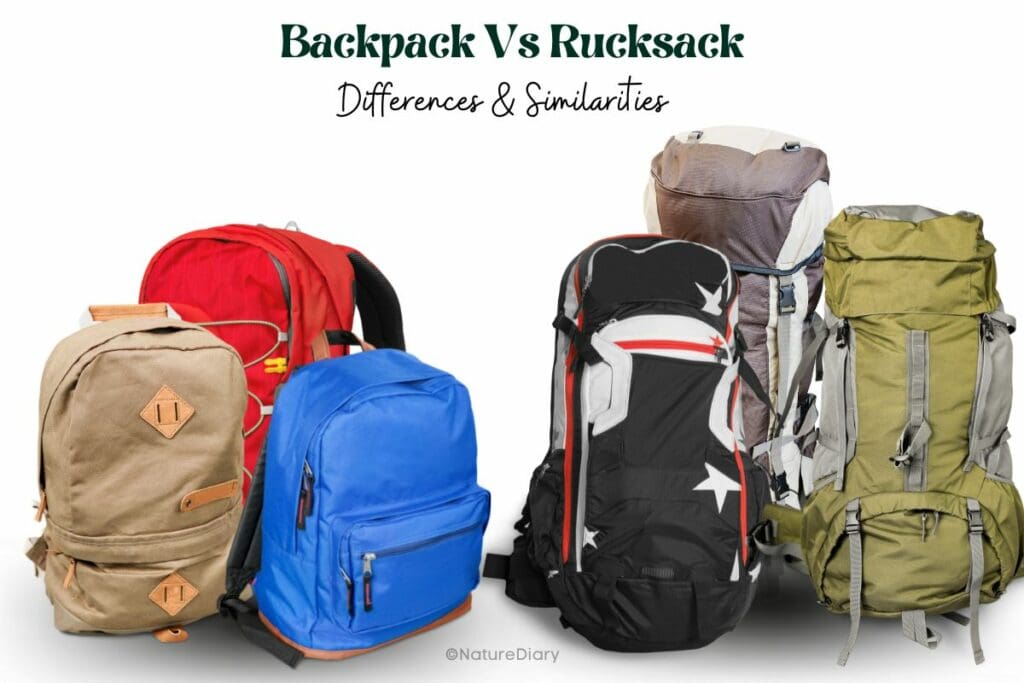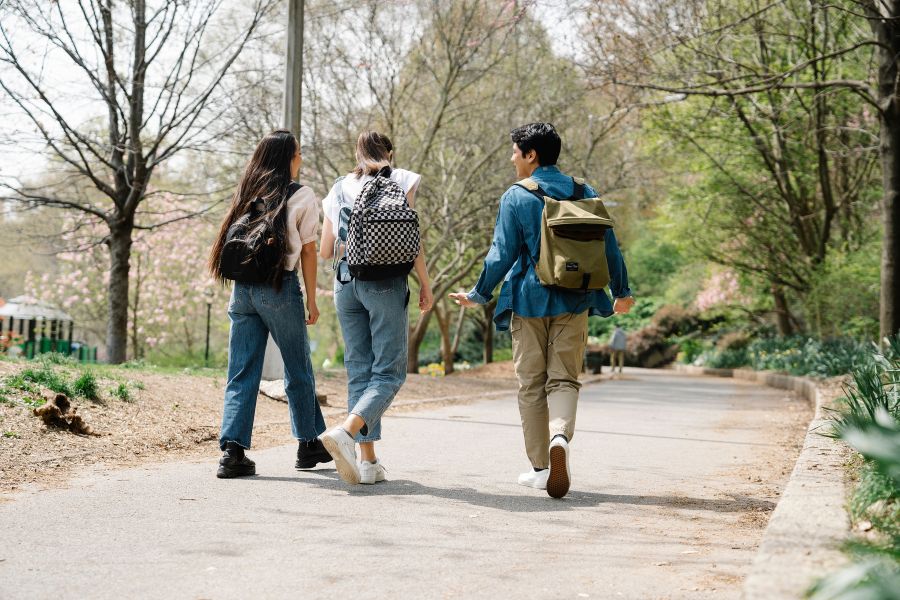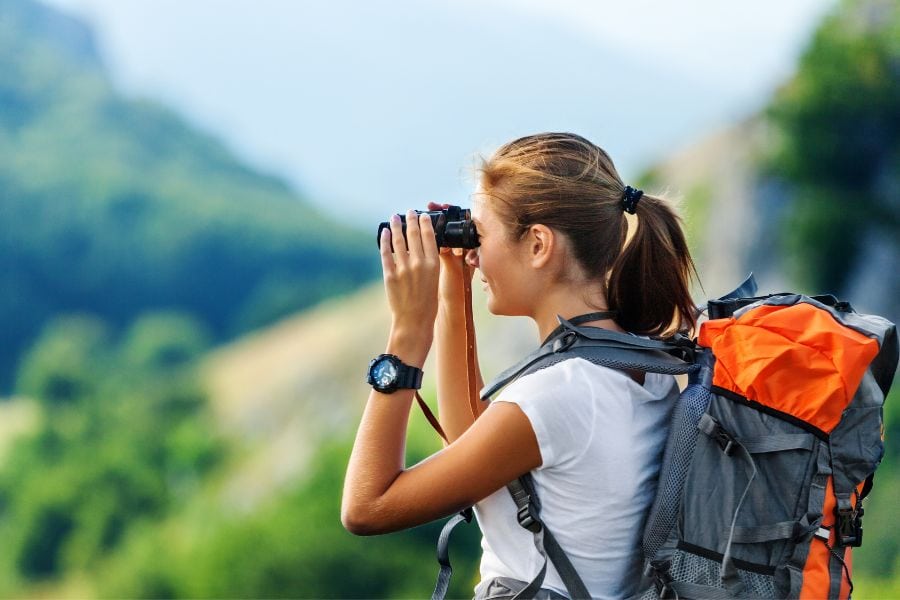Roomy luggage space, customized chambers to carry your belongings, and comfortable straps contouring your shoulders: you love trekking or hiking with your backpack, right? Well, have you ever been caught in the debate between backpack vs rucksack?
When I first started hiking, I often found my trek mates using the terms ‘backpack’ and ‘rucksack’ interchangeably. So, it was then I started marking out the difference between backpack and rucksack.
As an avid traveller, I have used both backpacks and rucksacks during my journeys. To bail you out of this dilemma, I have discussed their distinct features and uses. To give you a brief idea, rucksack is a subset of backpacks. However, rucksacks are sturdier compared to backpacks and are designed to carry heavier loads.
If you are just into this adventurous hobby or happen to be a travel photographer, you must be carrying heavy loads on your back. So, before you purchase these trekking accessories, it pays to understand the differences between rucksacks and backpacks.

What Is A Backpack?
As the name suggests, a backpack helps you carry loads on your back, serving as a bag with straps over your shoulder. Traditional backpacks are made of cloth, although you have sturdier materials in modern backpacks built with polyester and nylon.
Besides, these bags have several components. Hikers, trekkers, and even students can use backpacks. Compared to handbags, backpacks are convenient to use when you carry heavy loads. Besides, you also have customized backpacks on the market designed to carry laptops or specific accessories like camera gear.
Well, I have observed that although backpacks come with two shoulder straps, the padded hip belts carry most of the weight. The function of shoulder straps in backpacks is to place the bag in the right position with your torso as you walk.
Backpacks come in different categories based on their designs. These are daypacks, frameless backpacks, backpacks with internal and external frames. In most backpacks, you have the zipper or buckle mechanism to close them. Learn More: External Frame vs Internal Frame vs Frameless backpack.

Features Of Backpacks
- Unlike rucksacks, backpacks have several chambers in them.
- Most backpacks come with lower capacitates compared to rucksacks.
- Branded backpacks come with wide padded straps to ensure comfort.
- Some backpacks come with chambers for laptops, pens, and stationary.
- The zippers in a backpack have a locking mechanism.
- Some backpacks come with an expandible feature.
Uses of Backpacks
Besides carrying books and stationery, a backpack can be used to carry digital gadgets, laptops, books, office supplies, camping gear, and camera accessories. This extensive utility makes them more versatile and flexible. You can use them in your city as well as on your camping trips.
I highly recommend my fellow travellers to choose the right type of backpack depending on the activity they indulge in. For instance, if you travel frequently, get yourself a good quality travel backpack. Apart from it, you have casual backpacks, camping backpacks, hiking backpacks, laptop backpacks, and camera backpacks for specific purposes.
Based on the use, the number and design of the pockets vary significantly. If you like trekking, check out the most useful trekking backpacks for your trip. Likewise, if you go for a picnic, you need a specific design to complement your activity.
What Is A Rucksack?
While comparing backpack and rucksack, I have already mentioned that a rucksack is a type of backpack. However, it finds more use among trekkers due to its robust design and ability to carry more loads.
Usually, rucksacks have one large opening at the top, allowing the users to access the hollow chamber inside. Besides, rucksacks have more openings to carry different trekking or hiking accessories. However, these openings add to the weight of rucksacks considerably.
During my treks, I use the external chambers to carry my first aid kit, medicines, rain cover, poncho, and other accessories that I might need on an emergent basis. You should know how to pack your rucksack to ensure that you make room for all your travel accessories.
Trekkers, hikers, and the military usually use rucksacks since these backpacks are designed to carry everything a person may need for a few weeks. In customized rucksacks, you also have the provision for carrying your trekking poles and sleeping bags.
High-quality rucksacks are made from durable canvas. These backpacks have a greater number of loops, belts, pockets, and compartments. Compared to regular backpacks, they are capable of making room for more accessories.
While carrying rucksacks during my treks, I use both the chest and hip belts for better support and balance. The main entry point, however, is at the top, which you need to tie or clinch to close.

Features Of Rucksacks
- Compared to backpacks, rucksacks can accommodate more load. You can purchase backpacks with different load capacities like 30L, 45L, 60L, 80L, and even 90 L.
- The number and size of compartments in a rucksack are enough to accommodate bulky travel accessories.
- The top flap of rucksacks can accommodate your medicines, rain cover, or any other emergency accessory.
- They have a greater number of loops and strap for better balance.
- Usually rucksacks don’t have lockable zippers, and you need to depend on the clinching, external locks or tying mechanism.
Uses Of Rucksacks
Rucksacks, compared to backpacks, are more rugged and have a higher load-bearing capacity. So, you can carry a rucksack for weeks with all your necessities and provisions during your treks.
The size and robustness make rucksacks more suitable for trekking, hiking, and camping. This is one of the key differences between a backpack and a rucksack.
Besides, travelling with a comfortable, spacious and lightweight rucksack is much more convenient as you can enjoy a greater comfort and ease. However, you can’t carry small objects like diaries or books solely in rucksacks. So, these trekking accessories are mainly used by trekkers, hikers, rock climbers, and the military.
So, What Are The Differences Between Backpack And Rucksack?
- Design: The prime difference lies in their design. A backpack is usually smaller in size, comes with zippers and several compartments. On the other hand, a rucksack comes with a tying or clinching operation at the top with one large compartment with some additional pockets. Rucksacks are also bigger in size to accommodate more space.
- Capacity: Backpacks generally serve purposes when you have not more than 30L of load. On the other hand, rucksacks can hold trekking accessories up to 90L. So, an 80L rucksack can also be called a trekking backpack, whereas a 30 L backpack for casual purposes is not a rucksack. Being bulkier, rucksacks are less suitable for air travel as cabin luggage than smaller backpacks.
- Purpose: Backpacks are more suitable for short trips, particularly if you go for day walks and hiking. Rucksacks, due to their larger size and more powerful design, are perfect for expeditions, treks, camping, expeditions, and military operations.
Among different types of travel bags, both rucksack and backpack have some similarities, so, you need to be choosy about their utility. For instance, you can use a rucksack for backpacking, camping, or hiking. However, a backpack doesn’t suit all these purposes if your load is too high.
In terms of similarities, both these types of travel gear are available in lightweight models and waterproof materials. Since you already know the differences, it would be easier for you to plan your trip!